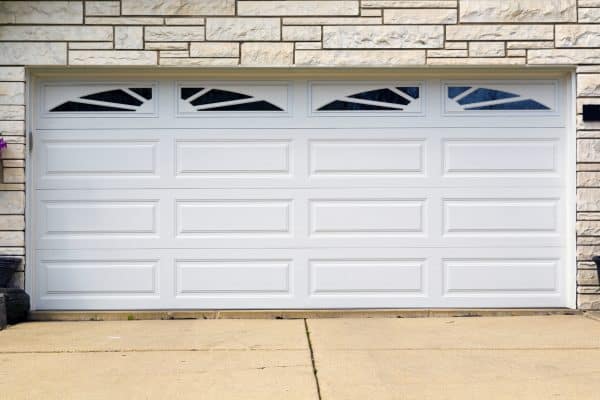A garage door is more than just a functional entryway to your home. It’s a significant architectural element that can dramatically impact your home’s overall curb appeal and security. With a wide range of styles, materials, and functionalities available, choosing the right garage door can be a daunting task.
In this guide, we’ll delve into the diverse world of garage doors, exploring the four primary types: sectional, roll-up, tilt-up, and side-hinged. By understanding the unique characteristics and benefits of each, you can make an informed decision that complements your home’s aesthetic and enhances its value.
So, let’s embark on this journey to discover the perfect garage door that will not only safeguard your vehicle but also elevate your home’s exterior to new heights.
Types of Garage Doors
Sectional Garage Doors
Sectional garage doors are the most popular type, offering versatility, energy efficiency, and customization options. They consist of multiple horizontal sections that lift and retract into a compact space above the garage opening. This design allows for smooth operation and easy installation.
Advantages:
- Customizable: Available in various styles, materials, and colors
- Energy-efficient: Can be insulated to reduce heat loss and gain
- Smooth operation: Reliable and quiet
Disadvantages:
Complex installation: Requires precise measurements and alignment
Roll-Up Garage Doors
Roll-up garage doors are a sleek and modern option that saves space. A single sheet of material, often aluminum or steel, rolls up into a coil above the opening. This design offers a clean, minimalist look, making it popular for contemporary homes.
Advantages:
- Space-saving: Compact design
- Sleek appearance: Modern and stylish
- Easy maintenance: Simple to clean and repair
Disadvantages:
- Less durable: Prone to damage from impact
- Limited customization: Fewer style options
Tilt-Up Garage Doors

Tilt-up garage doors are a classic choice that offers simplicity and affordability. A single, solid panel tilts upward and inward as it opens. This design is straightforward and easy to maintain, making it a popular choice for budget-conscious homeowners.
Advantages:
- Simple design: Reliable and low-maintenance
- Affordable: Cost-effective option
- Easy to repair: Simple components
Disadvantages:
- Limited design options: Fewer customization possibilities
- Potential for damage: Can be susceptible to damage from wind and debris
Side-Hinged Garage Doors
Side-hinged garage doors are a unique and historic option that adds character to your home. These doors swing open horizontally, similar to traditional barn doors. They are ideal for homes with a rustic or traditional architectural style.
Advantages:
- Unique appearance: Adds character and charm
- Ideal for historic homes: Complements traditional architecture
- Durable: Built to last
Disadvantages:
- Requires ample space: Needs room on either side of the opening
- Can be heavy: May require additional hardware for support
Factors to Consider When Choosing a Garage Door Replacement
When selecting a garage door replacement, several factors should be considered to ensure it meets your specific needs and enhances your home’s aesthetic appeal.
Material
The material of your garage door significantly impacts its durability, appearance, and maintenance requirements. Common materials include:
Steel:
A popular choice for its strength, durability, and affordability. It’s available in various gauges and finishes, offering a wide range of styles.
Aluminum:
Lightweight and corrosion-resistant, aluminum garage doors are low-maintenance and offer a modern look.
Wood:
Provides a classic, timeless appeal. Wood doors require regular maintenance, including painting or staining, to prevent weathering.
Fiberglass:
A durable and energy-efficient option that mimics the look of wood without the maintenance.
Style
The style of your garage door should complement your home’s architecture. Consider these popular styles:
Traditional:
Features raised panels, carriage house doors, or decorative hardware.
Modern:
Clean lines, minimalist design, and often made from materials like aluminum or steel.
Rustic:
Wood or wood-like materials, often with a distressed or weathered finish.
Insulation
Insulation is crucial for energy efficiency, especially in colder climates. Look for R-values that meet your specific needs. Higher R-values provide better insulation.
Hardware
High-quality hardware, including springs, rollers, and tracks, ensures smooth and reliable operation. Consider options like:
- Steel rollers: Durable and affordable
- Nylon rollers: Quiet and low-friction
- Belt-drive openers: Quieter than chain-drive openers
Automation
Smart garage door openers offer convenience and security. Consider features like:
- Remote control: Open and close your garage door from anywhere
- Smartphone app: Monitor and control your garage door from your phone
- Voice control: Integrate with smart home systems for hands-free operation
By carefully considering these factors, you can select a garage door that not only enhances your home’s curb appeal but also provides optimal functionality and security.
Your garage door is more than just a functional entryway; it’s a key component of your home’s exterior. By understanding the different types of garage doors and the factors to consider when selecting a garage door replacement, you can make an informed decision that enhances your home’s curb appeal, security, and energy efficiency.
Whether you opt for the versatility of sectional doors, the sleek design of roll-up doors, the simplicity of tilt-up doors, or the unique charm of side-hinged doors, remember to choose a style and material that complements your home’s architecture and personal preferences.
By investing in a high-quality garage door, you’re not only improving your home’s appearance but also increasing its value.

